
8 minute read
Accommodating Pregnant Women in General Classes –Chris Saudek and Rachel Frazee
from Yoga Samachar FW2016
by IYNAUS
ACCOMMODATING PREGNANT WOMEN IN GENERAL CLASSES
BY CHRIS SAUDEK AND RACHEL FRAZEE
Advertisement
Whether a pregnant woman is a brand new beginner or an experienced student, accommodating her in a
general class and keeping the class moving along can be a challenge to some teachers. But Iyengar Yoga, with its emphasis on individualized instruction and creativity within an excellent system, is ideal for working with pregnant women in any level class. Of course, it would be most beneficial to have a separate class just for pregnant women, but that is not always possible because of the busy schedules of both the pregnant women and most yoga studios.
It is much easier to accommodate a special need such as pregnancy when the student consistently attends a regular class. The teacher can more easily plan a class and anticipate special poses or setups for a pregnant woman. For example, the first poses that should be learned by pregnant women are Baddha Konasana, Upavistha Konasana, Bharadvajasana I, and Supta Baddha Konasana, which are very beneficial poses for all students, but especially for pregnant women. Pregnant women should be asked to memorize the names of these poses because they will be given as alternatives to certain poses throughout a series of classes. (For example, these asanas will replace the Navasanas and the closed twisting poses such as Marichyasana III and Ardha Matsyendrasana, to name a few).
In Yoga: A Gem for Women, Geeta Iyengar states that “those who have conceived may, for the first three months, practice all the asanas and pranayama given in this book except Urdhva Prasarita Padasana, Jathara Parivartanasana, Navasana, and all asanas from Section VII” (the backbending section). However, she also warns that pregnant women must be careful during the first three months because there are chances of miscarriage during this period. Therefore, even though Geeta does not mention modifying for the closed twisting asanas, such as Parivrtta Trikonasana, Parivrtta Parsvakonasana, Marichyasana III, and Ardha Matsyendrasana I, to name a few, we recommend that pregnant women, from the moment they indicate to us that they are expecting, modify for these poses. Hence, they are instructed to do Utthita Trikonasana and Utthita Parsvakonasana (both against the wall for support), a wide Marichyasana I (see photo 1), or Bharadvajasana I instead of the above.
Some of the syllabi in the IYNAUS Certification Manual can be explored to better illustrate specific accommodations both for the pregnant student new to Iyengar Yoga as well students who have been regular students for some time.
Chris Saudek, Uthitta Padmasana, 1985
Introductory I Syllabus A pregnant woman at any stage of pregnancy can practice all of the poses listed on the Introductory I syllabus with small modifications. All of the lateral standing asanas should be performed with the back to the wall (or trestle) with a block for the hand for balance and support (see photo 2). Parsvottanasana and Virabhadrasana I can be done facing the wall with hands on the wall. After the first three or four months, other modifications should be made to ensure more room for the growing baby. Yoga: A Gem for Women and many other books outline common modifications. For poses such as Tadasana, Utkatasana, Malasana, and some of the standing forward bends (Uttanasana, Padangusthasana, and Padahastasana), one will have to take the feet to hip distance apart as the pregnancy progresses past three months.
Marichyasana I should also be done with a wider stance (see photo 1). Also, both the standing and seated forward bends (including Parsvottanasana, Prasarita Padottanasana, and Triang Mukhaikapada Paschimottanasana) should be done in the concave back position with extra support of a strap, blocks, blankets, or wall to make more room for the growing baby. Getting into and out of Salamba Sarvangasana as one progresses through pregnancy can be difficult. For this reason, we suggest walking up the wall (see photo 3). Supta Konasana with support (see photo 4) is a nice variation that is relaxing for the expectant mother but keeps space in the pelvic region for the baby. Setubandha Sarvangasana is generally modified by doing cross pillows (see photo 5).
Introductory II Syllabus There are a few more asanas to address in this syllabus. Poses such as Garudasana should be done with the arms only. Virbhadrasana III needs support of both the arms and back leg (see photo 6). The Navasana poses are replaced by seated poses such as Baddha Konasana and Upavistha Konasana. Bharadvajasana I or a wide Marichyasana I replace closed seated twists, while Utthita Trikonasana, Utthita Parsvakonasana, and Ardha Chandrasana are alternative poses for the standing closed twists. Utthita Parsva Hasta Padangusthasana with support (see photo 7) can be done instead of Utthita Hasta Padangusthasana or any part of Supta Padangusthasana. Variations for Urdhva Mukha Svanasana, Ustrasana, and Dwi Pada Viparita Dandasana on the chair are shown in photos 8a, 8b, and 8c, respectively. Sirsasana can be continued if a student was proficient in the pose before pregnancy with the only modifications being to take support of the wall and keep the legs wider apart (see photo 9). Forward bends should all be done in the concave back position.
Intermediate Junior I and More Advanced Syllabi Of course, the standing asanas with use of support, the concave forward bends, and many seated poses will help a regular student who is pregnant remain strong and free from aches and pains from carrying the added weight. The inversions are important for strength and a peaceful mind. As Geeta has written in Yoga: A Gem for Women, “yogasanas… strengthen the pelvic muscles and improve blood circulation in the pelvic region, they strengthen the reproductive system, exercise the spine, and make the period of confinement bearable.”
Once we come to these syllabi, the same precautions and modifications as previously mentioned apply. From this point on, we assume a pregnant student has been a long-time regular student before pregnancy, knows the names of the alternate asanas, and is able to set up the modifications. It is important to make modifications for more “advanced” poses so that the pregnant woman who has been a long-time student does not feel limited to more beginning poses. She can learn to adapt many poses by keeping in mind her comfort as well as making more space for the baby. For example, Parivrtta Janu Sirsasana with support (see photo 10) can be a great relief for pregnant women who get backaches or feel compression in the side waist area. Another option is a standing version of Supta Padangusthasana III done with the use of the wall and a stool (see photo 11).
Relaxation is especially important for the pregnant woman. In the beginning, Viparita Karani (see photo 12) can help to relieve morning sickness. It is a very restful pose, so at all stages of pregnancy, it can be used when a pregnant student begins to show signs of fatigue during class. Savasana, Supta Baddha Konasana, and pranayama with support of bolsters (see photo 13) are all boons for the pregnant woman in the later stages of pregnancy as well as in labor between contractions.
Adjusting poses for the pregnant woman in all levels of classes so that she is safe and well cared for helps her feel confident and positive in her mind and strong in her body throughout the pregnancy. For teachers, it can be a creative endeavor and very rewarding.
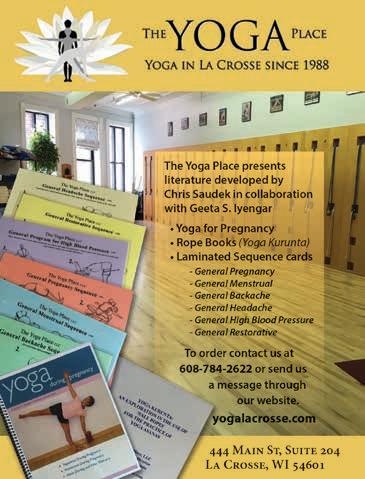
A wide Marichyasana I is a good alternative for the closed twisting asanas. should be performed with the back to the wall (or trestle) with a block for the hand for balance and support. The wall makes it much easier to get into and out of
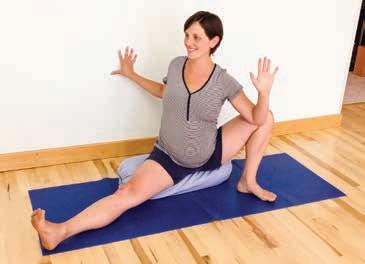
Supta Konasana with support is relaxing for the expectant
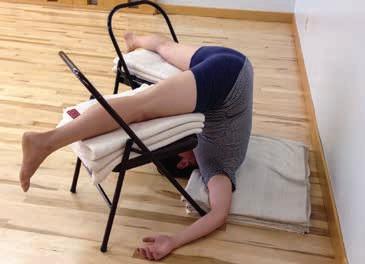
Ardha Chandrasana (and the other lateral standing asanas) mother and keeps space in the pelvic region for the baby.
5.
Setubandha Sarvangasana is generally modified using

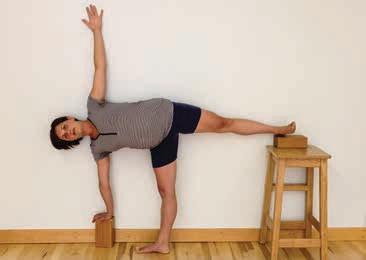
cross pillows. Salamba Sarvangasana.
6.
Virabhadrasana III needs support of both the arms and back leg.
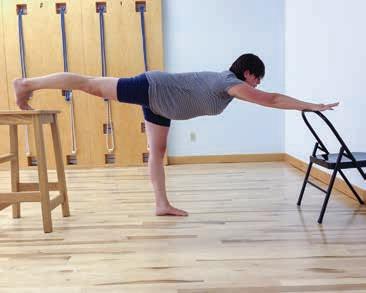
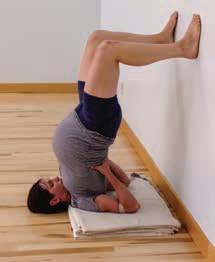
Pregnant women can perform Utthita Parsva Hasta Padangusthasana with support instead of Utthita Hasta Padangusthasana or any part of Supta Padangusthasana. Urdhva Mukha Svanasana can be modified using a chair or stool. 8b. Ustrasana can be modified using a chair, bolsters and blankets, and ropes when available.
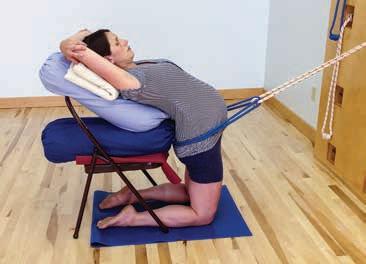
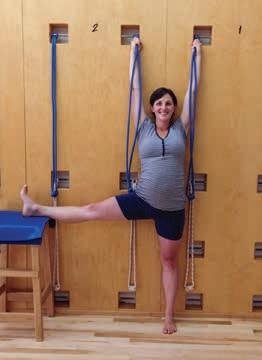
8c. Dwi Pada Viparita Dandasana is modified over the chair
8a.
with support for the neck and shoulders.
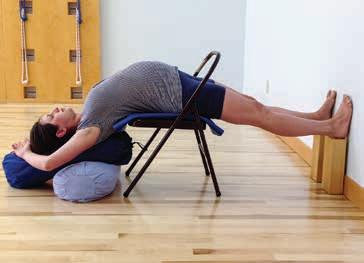

9.
Modify Sirsasana using support of the wall and legs wide apart.
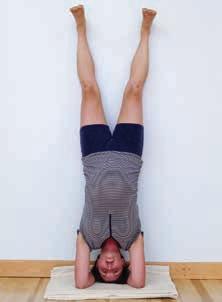
10. Parivrtta Janu Sirsasana with support can be a great relief for some pregnant women who get backaches or feel compression in the side waist area.
Supta Padangusthasana III can be done with the use of the wall and a stool.
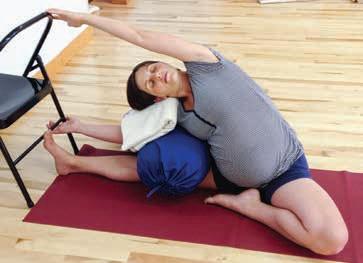
12. During early pregnancy, Viparita Karani can help to relieve morning sickness and is a very restful pose at all stages
of pregnancy.
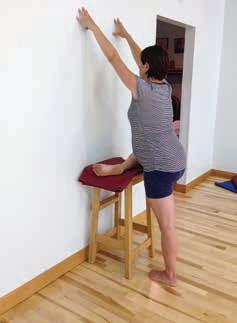
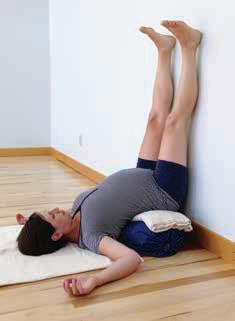
13. Savasana, Supta Baddha Konasana, and pranayama with support of bolsters are all boons for the pregnant woman in the later stages of pregnancy as well as in labor between contractions.








